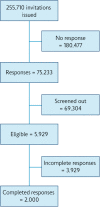Chronic obstructive pulmonary disease and exacerbations: patient insights from the global Hidden Depths of COPD survey
- PMID: 23971625
- PMCID: PMC3765923
- DOI: 10.1186/1471-2466-13-54
Chronic obstructive pulmonary disease and exacerbations: patient insights from the global Hidden Depths of COPD survey
Abstract
Background: Although chronic obstructive pulmonary disease (COPD) is a major global health burden there is a lack of patient awareness of disease severity, particularly in relation to exacerbations.
Methods: We conducted a global patient survey using an innovative, internet-based methodology to gain insight into patient perceptions of COPD and exacerbations in a real-world sample typical of today's working-age COPD population.
Results: Two thousand patients with COPD (53%), chronic bronchitis (52%) and/or emphysema (22%) from 14 countries completed an online questionnaire developed by the authors. The Medical Research Council (MRC) breathlessness scale was used to delineate symptom severity. Over three quarters of patients (77%) had experienced an exacerbation, with 27% of MRC 1 and 2 patients and 52% of MRC 3, 4 and 5 patients requiring hospitalization as a result of an exacerbation. While a majority of MRC 1 and 2 patients (51%) reported being back to normal within a few days of an exacerbation, 23% of MRC 3, 4 and 5 patients took several weeks to return to normal and 6% never fully recovered. A high proportion of patients (39%) took a 'wait and see' approach to exacerbations.Despite the high prevalence of exacerbations and their negative impact on quality of life, 73% of MRC 1 and 2 patients and 64% of MRC 3, 4 and 5 patients felt that they had control of their COPD. However, 77% of all patients were worried about their long-term health, and 38% of MRC 1 and 2 patients and 59% of MRC 3, 4 and 5 patients feared premature death due to COPD.
Conclusions: To reduce the adverse effects of COPD on patients' quality of life and address their fears for the future, we need better patient education and improved prevention and treatment of exacerbations.
Figures







References
-
- WHO. World Health Statistics 2008. Available from: http://www.who.int/whosis/whostat/EN_WHS08_Full.pdf.
-
- European Respiratory Society/European Lung Foundation. European Lung White Book. European Respiratory: Society Journals Limited; 2003.
-
- Vermeire P. The burden of chronic obstructive pulmonary disease. Respir Med. 2002;96(Suppl C):S3–S10. - PubMed
-
- From the Global Strategy for the Diagnosis, Management and Prevention of COPD, Global Initiative for Chronic Obstructive Lung Disease (GOLD) 2011. Available from: http://www.goldcopd.org/ - PubMed
-
- Wouters EFM. Economic analysis of the Confronting COPD survey: an overview of results. Respir Med. 2003;97(Suppl C):S3–S14. - PubMed
MeSH terms
LinkOut - more resources
Full Text Sources
Other Literature Sources
Medical

